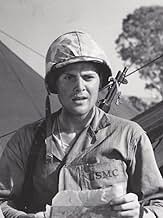Rip-roaring re-creation of WWII in the Pacific. It's more a tribute to Marine Corps fighting spirit than a traditional flag waver, even though it duplicates probably the greatest flag raising scene in US history. Wayne's perfect as the veteran Sgt. Stryker who must ready his squad for combat. At this career stage, Wayne is not yet an icon. Thus he shows his under-stated acting skills that were largely replaced by his sheer iconic presence later on. As a result, his thespic talent is too often under-rated by critics. The storyline, aside from combat, involves Stryker's difficulties with two of his men, played by Agar and Tucker. Tucker is something of a physical rival, while Agar does his duty to a Marine Corps father while rejecting the Corp's spirit. There's also brief time with girls while the guys are on leave, and I especially like the sensitive way Julie Bishop's status as a reluctant hooker is insinuated along with a lot of subtle heart.
Of course, the film's dramatic centerpiece is the lengthy combat footage. Budget-minded Republic went all out here. They blend effectively real war footage along with well done studio set-ups and location re-creations. The latter is largely thanks to the Corps cooperation which involves hundreds of real marine troopers. In fact, that beach-head footage of the assault on Tarawa may be the most intense of any post-war combat film. It's truly scary, as it should be.
Anyway, after seven decades the film may have lost some of its topicality, but the human elements remain, along with a fine turn by America's favorite cowboy, this time as a steadfast and heroic soldier.






































